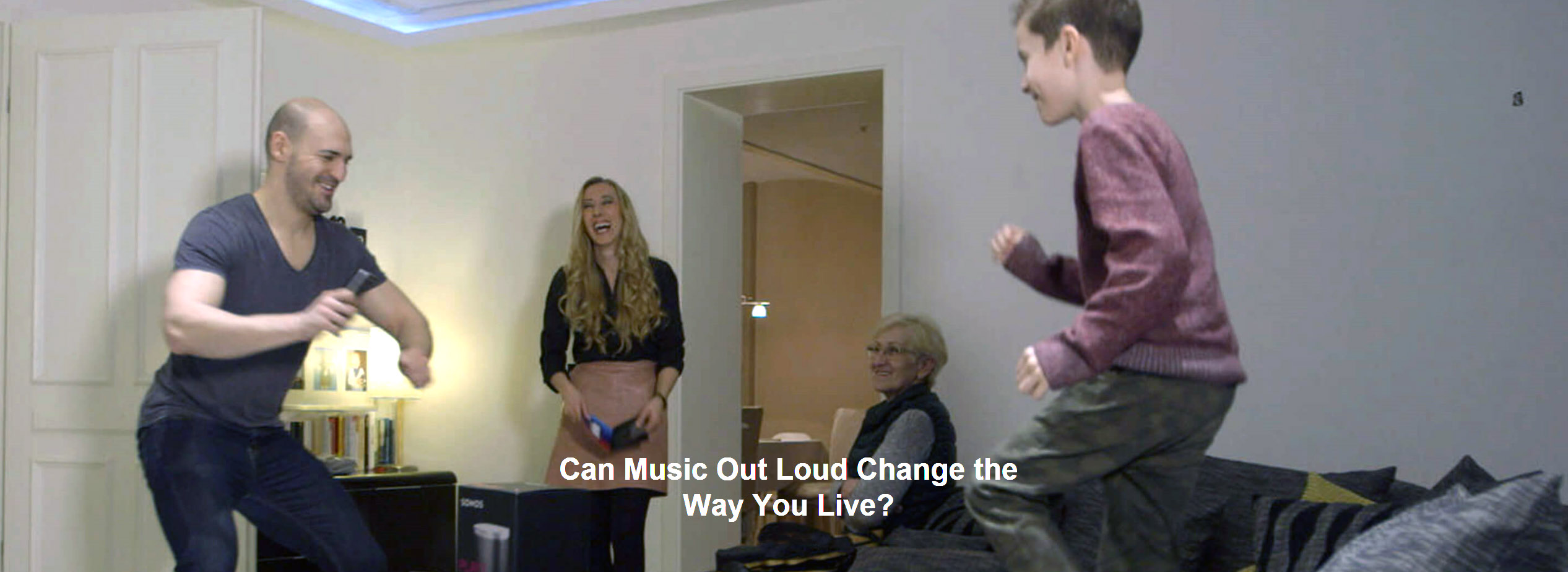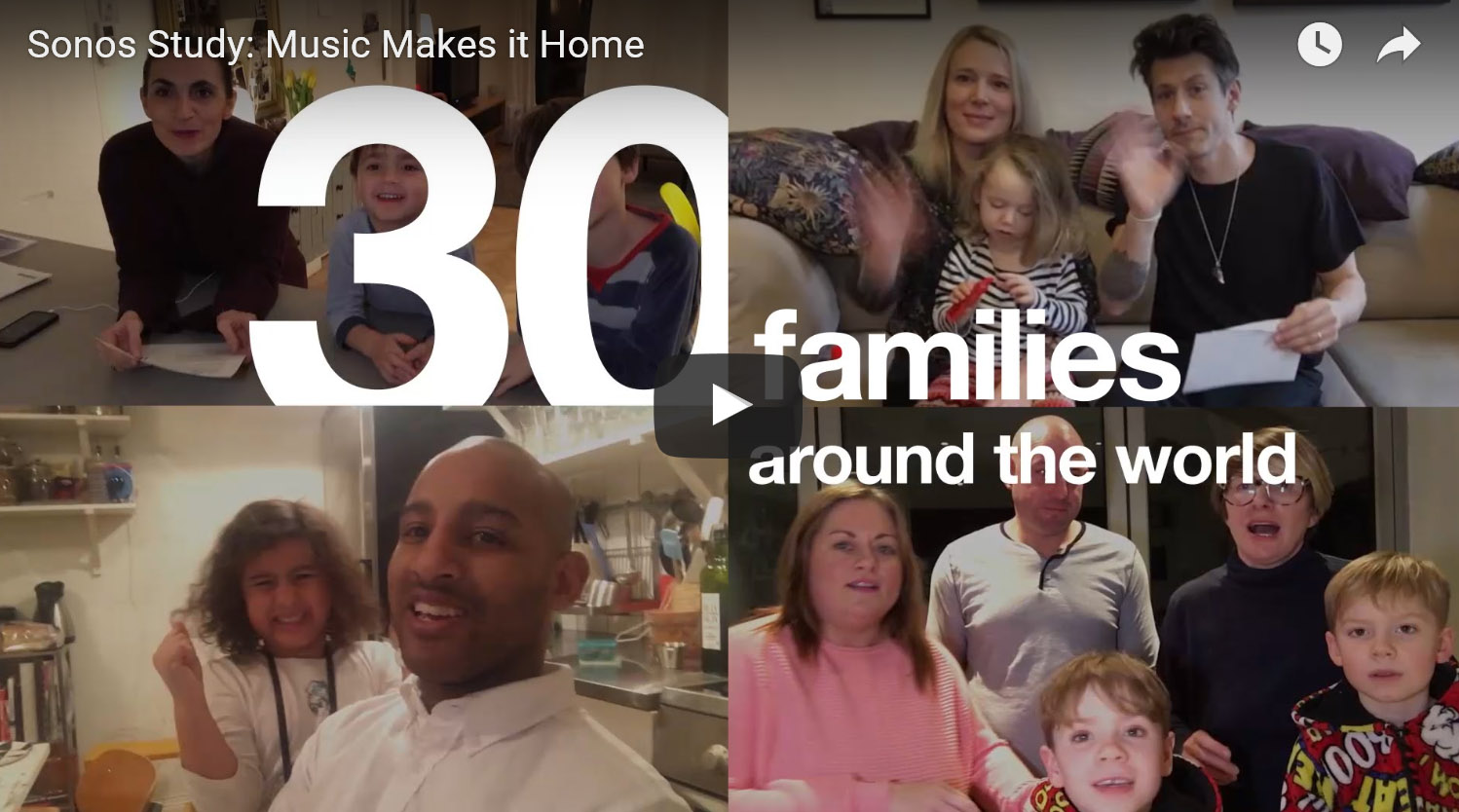Sonos, maker of HiFi WiFi speakers for home and work has a message for you:
Music out loud together makes life better! It goes beyond personal headphones. When played aloud at home, music can connect family and friends in primal ways that go back thousands of years.
To drive that point, Sonos launched its Wake Up The Silent Home campaign with a moody ad during last night’s Grammy’s. A recent Sonos sponsored global field study was loud and clear on these key insights:
It discovered a new and growing epidemic 67 per cent globally and 69 per cent of Canadians suffer from. Sonos describes this phenomenon as The Silent Home, where the absence of music exacerbates the stress and pressures of modern life. Here are key insights from the study:
- Listening to music out loud resulted in more time together, more “I love yous” and more sex.
- 44 per cent observed that a lot of their at-home listening takes place either alone or via headphones.
- 62 per cent of respondents noted that increasingly more of their social interactions take place in the digital world, while 46 per cent acknowledged that their family members spend more time interacting with technology than directly with each other.
The rise of The Silent Home has been a result of three different factors: changing expectations for privacy and autonomy within a family as a result of industrialization and education; the ease of “tuning out” with personal digital and mobile devices; and the highly addictive nature of social media and Internet browsing. SOURCE: Daniel J. Levitin, Ph.D., author of This Is Your Brain on Music
Tips to Waking Up The Silent Home – it’s not just all music:
- Make social spaces social
- Take screen breaks every 90 minutes
- Give time away to others, instead of hoarding it
- Keep phones away from the dinner table
- Optional but highly recommended: Invest in wire-free sound systems, like Sonos of course, that can stream music, including Spotify and Apple Music and spoken programs throughout a home with one or a few dozen smartly placed wireless speakers that can be programmed in groups from the comfort of your phone.
Here are more details on the Silent Home epidemic:
The Adult Fade:
- When we’re young, music defines us. It literally makes meaning out of the chaos of life. It shapes who we hang out with, how we dress, it becomes part of who we are. Because it’s everything, we listen to it nonstop— anywhere, any way, on any device— no matter how crappy. Of course, we continue to love music as adults. But somewhere around the time we get our first job with health insurance, our first place to live, a partner to whose social calendar we must adapt; music starts getting squeezed to the margins. We hit the adult fade. SOURCE: Joy Howard, Sonos
- 60 per cent of music lovers surveyed across nine countries conceded that they listen to less music now than when they were younger.
SOURCE: The Silent Home Assessment, Sonos, 2017.
Acute Hyper-Scheduling and The 24/7 Work Week:
Busyness has become a status symbol – an extraordinary departure from most of history, when not being busy was a demonstration of high status, and busyness was an indication either of low status or of deeply confused priorities. SOURCE: Oliver Burkeman, Author and Journalist
- 58 per cent of all Silent Home Assessment respondents acknowledged the desire for a better work/life balance.
SOURCE: The Silent Home Assessment, Sonos, 2017.
Anti-Social Listening:
The open floor plan allows for much greater sound transmission through the home, which can encourage interaction and engagement or can further reinforce family members’ search for a private space to get away from the overstimulation they’re experiencing both within and outside the home. SOURCE: Sonos
- 44 per cent observed that a lot of their at-home listening takes place either alone or via headphones.
SOURCE: The Silent Home Assessment, Sonos, 2017.
Screen-Induced Isolation:
Technology is primarily used in solitary pursuits. And when it is used with others in connecting through gaming or online communication, it still takes the person away from opportunities to engage in home activities that include others. SOURCE: Larry D. Rosen, Ph.D., author of The Distracted Mind
- 62 per cent of respondents noted that increasingly more of their social interactions take place in the digital world, while 46 per cent acknowledged that their family members spend more time interacting with technology than directly with each other.
SOURCE: The Silent Home Assessment, Sonos, 2017.
Conditions of The Silent Home:
- 72 per cent of Canadians report a shortage of meaningful conversations at home.
- Over half (55 per cent) note their households spend more time interacting with technology than each other.
- 85 per cent of Canadians shared that they’d like to spend more time doing activities in-person with family and friends.
Remedies for Breaking the Silence:
Make Social Spaces Social
- Home sound systems can deliver everything from mood-enhancing soundscapes to engaging political content to intellectually-simulating lectures. They can be the instrument of change. SOURCE: Levitin
- Reducing the isolation caused by immersive technologies can lead to more life satisfaction and better mental and physical health. SOURCE: Rosen
Take Screen Breaks
- Set aside designated times that are “internet free.” Start with “no device” family mealtimes. Employers can encourage employees to take “productivity hours” in which they turn off their email and even phones. SOURCE: Levitin
- Take short breaks every 90 minutes to reduce the over-activity that comes from using technology. SOURCE: Rosen
Give Time Away
- An important line of recent research offers a counterintuitive assessment of the time scarcity problem: a reliable way to achieve feelings of time affluence – that is, not being overbusy – is to give time away, to ‘spend’ it on others, rather than hoarding it. SOURCE: Burkeman
- Family systems theory research has indicated that families who enjoy 4 – 5 family meals each week show stronger family cohesion and a more homeostatic family system. And households that listen to music out loud share more meals together.
o According to the Sonos Music Makes it Home study, the households that listen to music out loud the most eat on average meals on 5.6 days per week, while households that listen to music out loud the least eat on average meals on 4.8 days a week. SOURCES: Rosen, Sonos




